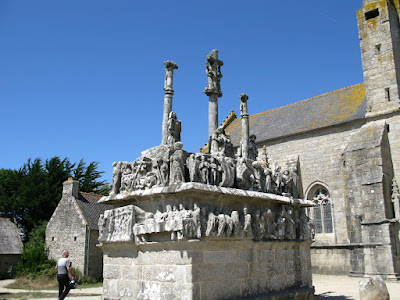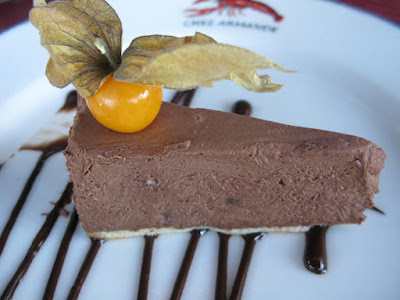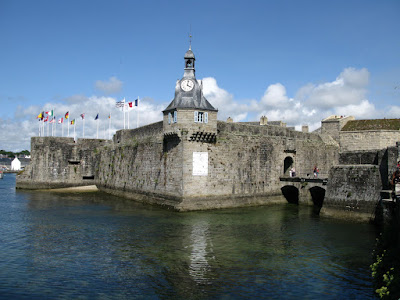
Tuesday was a small circuit around the area just east of us. We started out in the neighboring village of Pleyben, which has an impressive church and calvaire. A calvaire is a structure in the church close, or grounds, that depicts Calvary and the three crosses. They feature a variety of figures beneath the cross. At a time when almost everyone was a violation of church law for anyone other than a priest to possess a bible, the calvaires were used by the priests to explain various bible stories. It turns out that there are a variety of tourist trails to follow around here -- in California you might have the missions, here you could either collect all the calvaires, or perhaps all the church closes. In one guide book there is a list of about 15 church closes with a longer list for "advanced" fanciers.
(I should have initially pointed out that the road signs at the top of the post are in French first, then Breton, the Celtic language of the region, still spoken by some people.)



 After Pleyben, we went around in a circle, stopping at the charming church of St.-Herbot, the patron saint of horned cattle (where do they get these saints?). On the way, we were stopped by, well, cattle.
After Pleyben, we went around in a circle, stopping at the charming church of St.-Herbot, the patron saint of horned cattle (where do they get these saints?). On the way, we were stopped by, well, cattle. St.-Herbot is in a little wink of a village, with a stone entry on the side. The interior is unusual, with the alter area completely enclosed with a wooden structure. On several are wisps of hair from cattle.
St.-Herbot is in a little wink of a village, with a stone entry on the side. The interior is unusual, with the alter area completely enclosed with a wooden structure. On several are wisps of hair from cattle.





At this point we picked up the trail of the mountains, and climbed from the road to the peaks of the two tallest mountains in Brittany. They are about the altitude of our house in Berkeley.
The view of the peak of the second-highest mountain in Brittany from the road;
 the actual peak;
the actual peak; the view from the top.
the view from the top.
The chapel atop Mont St. Michel, the highest peak in Brittany. We walked up the stairs from the parking lot, since the road to the top was blocked off.

Wednesday we started exploring the region south of us, with a ride through the country side to find the oldest church in Brittany with the oldest (and we think) largest calvaire, with a rumored 100 figures (we didn't count them).


On the way we noticed the famous Breton black sheep grazing peacefully (at least until we stopped the car to look at them), and a dolmen (rock structure remaining from a burial tumulus or cairn).


We found a recommended restaurant in the middle of the countryside which claimed to be authentically Breton. I had a crepe with champignon (mushrooms), lardons (fried bits of ham) and creme fraiche. Tom had a traditional scallop stew with lots of apple. We enjoyed not only the food by the decorations of photos of folks in traditional dress, and samples of embroidery framed on the walls.

We had had discouraging information about a museum in Pont L'Abbe -- lifeless, but with a display of coiffes (I now find out the correct spelling). We found the town, found the parking, bypassed the temptations at the brocante (antique store or second-hand store, depending on the prices) and ultimately found the museum, depsite the town's best efforts to hide it. The first room was filled with coiffes, and a very nice guy who gave jus a demonstration. He told us that his mother had worn a coiffe and his aunt, and from them he learned how to do it. While the coiffe is rapidly dying out with the oldest generation, he told us that there are still many women in the surrounding villages who wear the coiffe in their daily lives. The museum displays quoted a few women saying that they did not feel comfortable going out without it, as a matter of identity and proper dress.
The Almost Impossible-to-find Museum
 The demonstration begins with dividing the hair and covering the back of the head with a little cap, twisting the ends into a bun, encasing the bun with a round comb (the English translation of the museum guide called this the "louse"), wrapping the comb in black velvet ribbon, pinning the back piece of the coiffe to the back of the comb, then placing the front piece and long ties of the coiffe on the comb, pinning all in place and typing a bow in the long ribbons. On a good day, 1/2 hour. Making one coiffe takes only about 10 hours for an experienced maker. Our demonstrator told us that the ironing of the collar we saw at the fete took 4 hours, using four or five hundred pieces of grass or twigs to mold the shape of the fabric.
The demonstration begins with dividing the hair and covering the back of the head with a little cap, twisting the ends into a bun, encasing the bun with a round comb (the English translation of the museum guide called this the "louse"), wrapping the comb in black velvet ribbon, pinning the back piece of the coiffe to the back of the comb, then placing the front piece and long ties of the coiffe on the comb, pinning all in place and typing a bow in the long ribbons. On a good day, 1/2 hour. Making one coiffe takes only about 10 hours for an experienced maker. Our demonstrator told us that the ironing of the collar we saw at the fete took 4 hours, using four or five hundred pieces of grass or twigs to mold the shape of the fabric.The back attached to the comb covered with ribbon.

The finished product.
 Samples throughout the years, starting with the smallest in about 1830, growing taller and taller each year until about 1970. Then shorter hair and women working at jobs made the coiffe impractical -- although the museum has video and photos of women in their coiffes helping in farm work, collecting seaweed like hay bales, cooking and canning fish.
Samples throughout the years, starting with the smallest in about 1830, growing taller and taller each year until about 1970. Then shorter hair and women working at jobs made the coiffe impractical -- although the museum has video and photos of women in their coiffes helping in farm work, collecting seaweed like hay bales, cooking and canning fish. There was also a nice exhibit of traditional costumes; this was my favorite.
There was also a nice exhibit of traditional costumes; this was my favorite. detail of the embroidery
detail of the embroidery A church we visited in Pont L'Abbe at the end of the day.
A church we visited in Pont L'Abbe at the end of the day.

Today we headed off to Concarneau, another harbor town, but so much more. We arrived at noon, so found a restaurant listed in two guides and settled in for langoustines (for Tom, in honor of the area, which produces the majority of langoustines in France) and a salmon and salad entre (appetizer) and veal (entre) for me, with a fondant du chocolat for shared dessert. The food was fine, good even, but the service was so slow we could have spent a whole three hours just being served, had we not ditched protocol and asked for the dessert at the same time as Tom's coffee, and the bill as soon as we received those. The parking policies in France are highly civilized -- paid parking is free at lunch, in this city from 12:30 to 2; but even so, it was not enough for this restaurant. As it was we watched three tables up and leave before ordering.
 One of Tom's langoustines was coated with peppery roe.
One of Tom's langoustines was coated with peppery roe.



Across the street from the restaurant was the Ville Close, actually a walled city covering an entire island in the harbor. Inside the walls was a bustling (dare we say crammed) town with wall to wall shops emphasizing ice cream, candy and pastries, and striped sailor T shirts. However, it also housed a Musee de la Peche (museum of fishing) which one of us found fascinating, the other one only mildly amusing. The museum did include a visit aboard an old fishing vessel tied up outside the wall, which both were interested to see.

A sewing machine for making sails in the museum; it was about 5 feet across.




A brief walk through the town, a brief climb onto the ramparts, and we were headed back for rest and recreation.


You knew this was a loop hole didn't you?



No comments:
Post a Comment